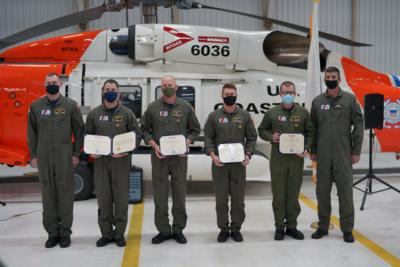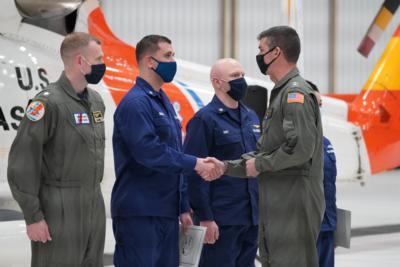Extraordinary Heroism Saved The Life Of A Lone Fisherman Adrift At Sea
The Coast Guard presented Air Medals to four crew members during a ceremony at Air Station Sitka Friday, for their role in the rescue of a fisherman near Meyers Chuck, Alaska, Nov. 1, 2020.

Rear Adm. Nathan A. Moore, commander, Coast Guard 17th District, presented Air Medals to Lt. Justin Neal, pilot; Lt. Jonathan Orthman, copilot; Petty Officer 2nd Class James Schwader, flight mechanic; and Petty Officer 2nd Class Grant Roberts, rescue swimmer.
“It is an honor for me to present the Air Medal to this crew who put their lives at risk and overcame extremely challenging conditions to save a life at sea,” said Rear Adm. Moore. “I am incredibly proud of them.”
The aircrew received the medals in recognition of the heroic actions and extraordinary measures taken to save the life of a lone fisherman adrift at sea.
At 5:30 p.m. on November 1, an alarm sounded at Air Station Sitka. An Emergency Position-Indicating Radio Beacon (EPIRB) registered to fishing vessel Irony had been activated in Earnest Sound, 150 miles southeast of Sitka. The crew departed the air station as a low-pressure storm system battered Southeast Alaska.
Low altitude freezing levels, total darkness and near zero visibility required the aircrew to almost double the normal straight line transit distance to a 265-mile transit around rugged terrain rising to 5,000 feet above the water. The increased transit length was compounded by a 70 mph headwind offshore which resulted in reduced speed, leaving the crew to focus on fuel planning with initial estimates allowing them only 15 minutes on scene. The crew was 115 miles into the flight when they descended to 300 feet above the water and exited the low clouds. As visibility slowly increased to two miles, the aircrew navigated off a low visibility route, cutting the distance to scene by 58 miles and conserving valuable fuel. Twelve miles from Ernest Sound, the EPIRB was heard by the flight crew and the copilot spotted a strobe light left of the aircraft. As the pilots carefully overflew the light to mark its position and set up an approach to the water, the rescue swimmer spotted through the helicopter’s
infrared camera a single survivor clinging to debris.

The rescue swimmer guided the flight mechanic’s searchlight to the survivor’s location to ensure the crew could maintain visual contact. The pilots were unable to turn the helicopter due to unrelenting winds, so the flight mechanic conned the pilots back toward the survivor and briefed the deployment and recovery plan. In an effort to make sure the survivor was not subjected to the helicopter’s rotor wash, the rescue swimmer was deployed into the water upwind of the debris. Receiving vectors from the pilots through a hand-held radio, the rescue swimmer swam through darkness and 12-foot waves for more than 10 minutes to reach the survivor who was then safely hoisted into the helicopter. Once in the cabin, the aircrew confirmed no additional crew aboard the sunken fishing vessel, provided care to the hypothermic survivor, and transported him to Ketchikan. A city-wide power outage, continued low ceilings and poor visibility led the pilots to request the awaiting ambulance turn on their
lights to assist them in locating the small helipad along the dark shoreline of town. Once on deck the survivor was transferred to emergency medical personnel.
The Air Medal is awarded to individuals serving with the Armed Forces who distinguish themselves by heroic or meritorious achievement in aerial flight.
 Classic Aero-TV: Remembering Bob Hoover
Classic Aero-TV: Remembering Bob Hoover ANN FAQ: Follow Us On Instagram!
ANN FAQ: Follow Us On Instagram! ANN's Daily Aero-Linx (05.15.24)
ANN's Daily Aero-Linx (05.15.24) ANN's Daily Aero-Term (05.15.24):Altimeter Setting
ANN's Daily Aero-Term (05.15.24):Altimeter Setting Aero-News: Quote of the Day (05.16.24)
Aero-News: Quote of the Day (05.16.24)




